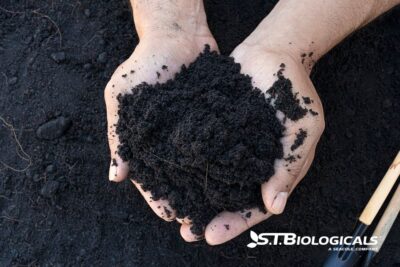Unlock the nutrients in your post-harvest stubble and fuel next year’s crops. Biological products like BIOACTIVE LiquiLife+ harness beneficial microbes to break down stubble, release nutrients, and improve soil health.
Post-harvest stubble contains valuable nutrients next year’s crop could use to grow healthy and plentiful. Unlock the potential of this year’s stubble with the help of beneficial bacteria, fungi, and other microbes. Biological products like BIOACTIVE LiquiLife+ contain thousands of strains of microorganisms that will break down stubble so the nutrients it contains is available to your cover crops or next year’s new plants.
Let’s take a closer look at how microbes break down stubble, bioconversion, and how biologicals can help.
Breaking Down Lignin and Cellulose in Post-Harvest Stubble
Essential nutrients are tied up in post-harvest stubble. For example, corn stubble is rich in nitrogen and other macronutrients. To make these nutrients available for next year’s cash crop, you need to break down the durable lignin and cellulose in the plant stubble.
Microbes in the soil produce enzymes that break down lignin, cellulose, and other tough fibers. The microbes attack the stubble’s surface. The enzymes they produce break down the lignin in the stubble at the macromolecular level. This unlocks the micronutrients and the nitrogen in the corn stubble and makes it available to the roots of your cover crops now or to your new crops in the spring.
How Bioconversion Works
The process of unlocking micronutrients from organic matter is called bioconversion. Bacteria, fungi, and other soil microorganisms, break down crop residues and stubble. This liberates micronutrients and macronutrients, such as nitrogen, phosphorus, potassium, and trace elements. They become part of the soil organic matter and available to plants in forms they can readily absorb.
Microbial activity not only increases plant vigor by release balanced packages of nutrients into the soil, it improves soil health overall. Microorganisms improve soil fertility, enhance soil structure, and increase its water-holding capacity, a huge plus during droughts. Healthier soils support more vigorous root systems and more resilient plants, leading to improved growth and higher yields over time.
The bioconversion process brings into play the principles of regenerative farming, contributing to a more sustainable agricultural practice. By returning organic matter to the soil and harnessing the natural activity of microbes, you can reduce your costly reliance on synthetic fertilizers. Breaking down stubble isn’t just about clearing fields. It’s a key step toward long-term soil health and more sustainable agriculture.’
Why Biologicals Matter
Biological products contain the microbes that assist in stubble degradation and bolster the natural defenses of the plants, making them more resilient to pests and disease. The presence of healthy, diversified soil organisms enhances the soil’s capacity to resist abiotic stress, paving the way for sustainable farming practices.
At ST Biologicals, we recommend BIOACTIVE LiquiLife+ from Purple Cow Organics for breaking down stubble after harvest. It contains thousands of beneficial bacterial and fungal strains that build soil health and help your plants use nutrients more efficiently. It’s approved for certified organic growers and works well in conventional systems, too.
For expert advice on how to incorporate biologicals and other regenerative ag practices on your operation, get in touch with the mentors at ST Biologicals. We have decades of experience helping farmers and ranchers work with Mother Nature to improve yields and maintain soil health and productivity for future generations. We’re here to help you succeed. When soil speaks, we listen.
Bioconversion FAQs
What is stubble bioconversion, and why is it important?
Bioconversion is the process where soil microbes break down crop residues, releasing essential nutrients like nitrogen, phosphorus, and trace elements. This makes nutrients available to cover crops or next year’s plants while improving overall soil health.
How do microbes break down tough stubble like corn stalks?
Microbes produce specialized enzymes that digest lignin, cellulose, and other rigid plant fibers, unlocking nutrients trapped in the stubble so plants can absorb them.
Why should I use biological products on my fields?
Biologicals introduce beneficial bacteria and fungi that accelerate stubble decomposition, enhance nutrient availability, and improve soil structure, water retention, and plant resilience. This can help you reduce your reliance on synthetic fertilizers.
Can biologicals be used in both organic and conventional systems?
Yes! Products like BIOACTIVE LiquiLife+ are approved for certified organic farming and also work effectively in conventional systems, making them a versatile tool for improving soil health and crop yields.

